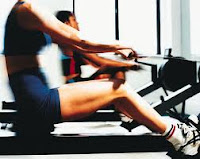Cut the Weight, Add the Vibe: Squatting on Vibration Plates - A Valuable Tool in Your HIIT & Conditioning Repertoire or Just Plain Out Embarrassing?
 |
| Disclaimer: This article contains prejudiced references to the way women train. Please don't take it personally, ladies; take it as a challenge to show us guys that you know better than that ;-) |
Now, aside from being talked about at the gym, the main reason to actually take my advice and relocate your squat workouts to the the whole body vibration plates is the increased energy expenditure you can achieve, when you're performing your squats on shaky grounds.
Good vibrations, bad vibrations?
In fact, according to the data, Daniel H. Serravite, David Edwards, Elizabeth S. Edwards, Sara E. Gallo and Joseph F. Signorile recorded, while their 10 active male graduate and undergraduate students (26.50 ± 5.06 years old, weight 83.18 ± 9.46 kg, height 184.0 ± 8.95 cm) without prior lifting experience were fidgeting on the vibration plates, clearly shows that the added "resistance" due to the constant vibrations decreases the energy efficacy and doubles the energetic demands of the exercise.
Now, while this will certainly not give you the bragging rights, a new PR on the bench or in the squatting rack would give you, the combination of light-weigh squats and full-body vibration could in fact be turned into a highly effective, compared to regular squats less injury prone (you will need much less weight) staple exercise in a HIIT-esque cardiovascular and fat burning workout.
How exactly did that work?
In the study at hand, the subjects performed 30 s sets of active squatting, using a range of motion from slightly below full extension to 1.57 rad, were performed at a speed of one squat per 3 s (controlled by a metronome).
 |
| No you don't have to wear a mask, as well - that was just necessary to ensure that the researchers would be able to measure energy expenditure and substrate utilization correctly. |
The nine training protocols represented different combinations of external load applied at shoulder level using a backpack (0%, 20%, and 40%BW) and vibratory condition (see Figure 1). Vibratory conditions ranged from no vibration (NV) to 35Hz at 2–3 mm (35L; 1.89g) and 50Hz at 5–6 mm (50H; 7.7g) (Pel. 2009). The vibratory conditions reflect the frequency–displacement relationships found to maximize neuromuscular performance in our earlier study (Adams. 2009).The equipment the scientists used was a synchronous WBV plate (Model Pro-5, Power Plate North America, Northbrook, IL).
And if you take a peak at the picture above (no not the in the head of the article, guys!) you'll notice that the external load was not, as I humorously implied in the introduction loaded an Olympic bar with 2x 25kg and 2x12.5kg weights on both sides, but rather put into sandbag containing backpack.
So how exactly would that look like in practice?
Let's take an example. If your 1-RM max on the squat were 200kg and you were usually squatting 40% (=80kg) of those for 10x10 with minimal rest in-between sets to turn your leg training into a fat burning, mitochondrial burning HIIT workout, you'd expend the "exact" same amount of energy if you performed those squats with only 20% of your 1-RM max on a vibration plate.
 |
| Figure 2: Oxygen consumption during recovery; * indicates sign. diff. from no vibration (Serravite. 2013) |
This does not mean that it won't benefit the activation of stabilizer muscles that would not be activated to the same extend during the regular squat on stable ground).
 |
| If the rowing machine is not already part of your personal repertoire of HIIT compatible workout equipment, I highly suggest you go back to the "Eight HIIT Sessions on the Rowing Ergometer Cut Body Fat, Increase Adiponectin, VO2Max & Performanc"-post from December 2012 (read more) |
And as an added bonus you will be activation muscles, of which many of you may not even have been aware that you had them.
This does not mean that you should forget about your previous HIIT workout regimen all-together. For those who don't care about being stared at at the gym the proposed combination of a high(er) rep, short rest squatting workout could yet become a new tool in their (hopefully already versatile) cardiovascular exercise repertoire.
References:
- Adams JB, Edwards D, Serravite DH, Bedient AM, Huntsman E, Jacobs KA, Del Rossi G, Roos BA, Signorile JF. Optimal frequency, displacement, duration, and recovery patterns to maximize power output following acute whole-body vibration. J Strength Cond Res. 2009 Jan;23(1):237-45.
- Pel JJ, Bagheri J, van Dam LM, van den Berg-Emons HJ, Horemans HL, Stam HJ, van der Steen J. Platform accelerations of three different whole-body vibration devices and the transmission of vertical vibrations to the lower limbs. Med Eng Phys. 2009 Oct;31(8):937-44.
- Serravite et al. Loading and Concurrent Synchronous Whole-Body Vibration Interaction
Increases Oxygen Consumption during Resistance Exercise. Journal of Sports Science and Medicine. 2013 [epub ahead of print].



